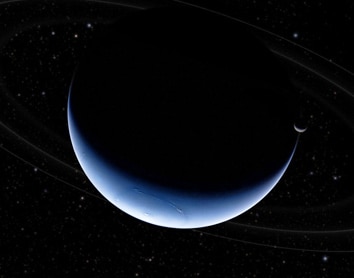Create a free profile to get unlimited access to exclusive videos, sweepstakes, and more!
A Hex on Neptune

Neptune gets short shrift in our solar system. Whether or not you think it’s the farthest-flung planet, it’s a long way out; 4.3 billion kilometers (2.7 billion miles) is a long walk in anyone’s book.
At high power through a small telescope it’s a barely discernible disk; I’ve seen it myself. It’s a lovely blue color, but too small to see features.
But then, that’s why we have spacecraft. Voyager 2 flew past Neptune in 1989, taking a lot of images of the planet as it swept past. I’ve always loved the pictures of it as a crescent, a view we can’t get from Earth; you have to go past the planet and look back toward the inner solar system to get that geometry right.
But even then, the very faint rings of Neptune and the background stars were invisible, since the Voyager camera was set to take exposures of the relatively bright cloud tops of the planet.
And that’s why, when I saw this image, my jaw dropped.
Oh yes, you want to click to embiggen that.
That stunning portrait is a composite of real images taken by Voyager and some more fanciful additions done by amateur astronomer Rolf Wahl Olsen. You may remember him as having taken amazing images of the edge-on disk of dust around the star Beta Pictoris, or the ridiculously deep and gorgeous image of the nearby active galaxy Centaurus A.
To make this shot, Rolf used the actual images of the planet’s crescent disk from Voyager, tweaking them a bit to enhance the cloud features. To add the rings, he used very long exposures to model their density profile, then added them to the planet picture. He added a shot of the moon Triton taken by Voyager 2 a few days after the Neptune encounter, taking care to place it about where it would’ve been seen from this angle. Finally, he added background stars based on the position of Voyager and the angle at which it was seeing Neptune.
So, when taken all together, this isn’t really a real picture of Neptune, but it does closely mimic what would’ve been seen had you been riding along with the Voyager 2 spacecraft as it shot past Neptune at over 55,000 kilometers per hour. And it’s gorgeous.
But there’s more …
As I looked at the image, I was surprised, and then a little shocked, at what I saw at Neptune’s south pole.
That looks for all the world—worlds—just like the huge hexagonal wind pattern blowing around Saturn’s north pole.
I’m no expert, but I had never heard of such a feature seen on Neptune before. I sent a note to my friend Heidi Hammel, an astronomer who studies the outer planets, and she noted that this feature does look similar to the hexagon on Saturn, but more careful processing and measurements of the image would have to be done. For example, it’s easy to be fooled in an image like this into thinking those lines are all at roughly the same Neptunian latitude, when they may not be.
She noted some other planetary scientists who would be interested in this, so I contacted them as well. They were excited to see it, though cautious as Hammel was. I don’t blame them! They’ll be looking into this more. I’ll note that back in the late 1980s and 1990s image processing was still pretty primitive, and what we can do now in a few clicks of a mouse is far in advance of what would’ve taken hours of work 25 years ago. It’s entirely possible this feature was hidden in plain sight all this time.
So, assuming it’s real for a moment, what is it? On Saturn, the hexagon is caused by winds blowing around the pole, very similar to the Earth’s jet stream. In our case the winds meander a lot around the pole, and don’t form a nice, neat geometrical shape. On Saturn, though, conditions are different, and those winds blow true. Regular polygons pop up naturally in such systems, weird as that may seem, but Saturn is proof of that.
Neptune and Saturn are similar in many ways. For example, in 2006 Hammel and others observed Neptune with the Keck and Gemini infrared telescopes and saw a bright spot at the pole, which was due to a warm “polar vortex” of methane and ethane, similar to a spectacular vortex seen on Saturn (not to be confused with the hexagon, I’ll note; these vortices are far smaller and localized at the pole).
So it’s possible that conditions on Neptune would indeed lead to a huge hexagonal wave around the pole as well. By eye, the latitudes of the two features look the same on both planets, too, but again it’s easy to be fooled. I’ll wait and see what the real experts say (and I’ll post a follow-up when they do).
I certainly hope this pans out. There’s a lovely poetry to this; we sent a probe out past Neptune, and in the intervening years our technology got so much better that a clever person could access that data, clean it up, and perhaps discover something that is both scientifically interesting and was missed by everyone else.
Science! I love this stuff.


























